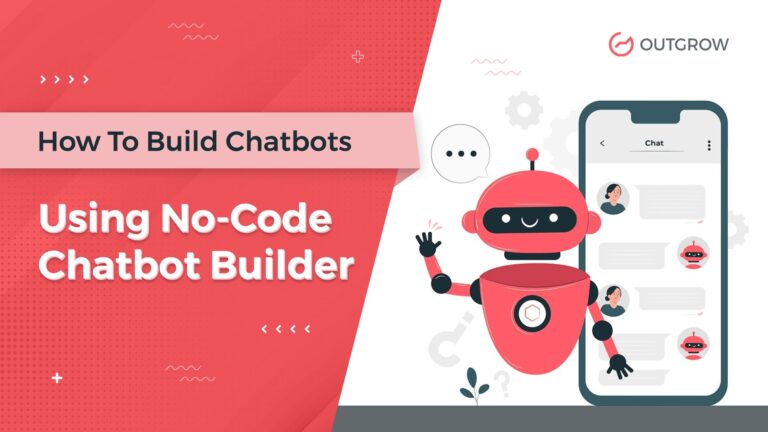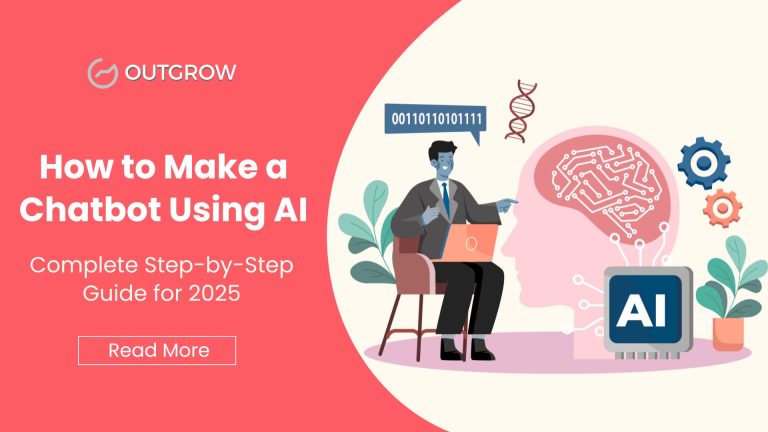How Do Chatbots Work? The Complete Guide to Understanding Chatbot Technology
Table of Contents
Ever wondered how those small windows of chat on websites appear to know what you are thinking? You’re not alone. Millions of users all over the world engage with chatbots every day without actually knowing the wizardry behind it.
The thing is, how chatbots work is a whole lot more interesting than people think. What were once basic script-readers have evolved into advanced AI-driven conversation companions that can tackle everything from customer support to intricate problem-solving.
The figures paint the picture: the industry for chatbots is going to reach a staggering $994 million by 2024, and the AI chatbot market will be valued at a staggering $46.641 billion by 2029 at a rate of CAGR 24.53%. More astonishing yet, a minimum of 67% of the world’s population have utilized chatbots for customer support, and 27% of consumers using customer support for assistance are unaware whether they spoke with a human or a machine.
If you’re a business owner interested in integrating chatbot technology or simply interested in the way these virtual assistants work, this guide will demystify everything you want to know about chatbot architecture, AI chatbot technology, and real-world applications that are revolutionizing the way we communicate online.
What Is a Chatbot and Why Should You Care?
Let’s start with the basics. What is a chatbot? Think of it as a computer program designed to simulate human conversation. But here it is interesting: not all chatbots are made the same.
The easiest way to understand chatbots is to think of them as digital employees who never sleep, never take a break and can handle thousands of conversations at the same time. They are programmed to understand what you ask and respond in this way that seems natural and useful.
What is a chatbot used for? The applications are practically endless:
- Customer support and service
- Lead generation and sales (in which interactive content such as calculators can increase conversion by as much as 40%)
- Appointment setting
- FAQs
- E-commerce support
- Entertainment and interaction
The best thing about today’s chatbot technology is that it is so versatile. One chatbot can do several jobs, vacillating between customer service agent, sales support, and technical support expert based on what the user requires.
This is what the statistics reveal regarding chatbot efficiency: 80% of companies experience a 67% revenue surge, while 26% of total transactions are generated directly from chatbot interactions. Chatbot interactions cost an average of $0.50 per interaction, while interactions with humans cost an average of $6.00.
Interactive Assessment Concept: Design a “What Kind of Chatbot Does Your Business Require?” calculator that assesses visitor needs and suggests rule-based versus AI chatbot solutions.
Rule-Based Chatbots vs AI Chatbots
Understanding how chatbots work means knowing that there are two main flavors: rules-based and AI powered. Each has its own strength, and the choice between them can make or break your Chatbot strategy.
How Do Rule-Based Chatbots Work?
Rules-based chatbots are like following a selected-based book. They work with predetermined decision trees with specific triggers and reactions. When you ask a question, chatbot scans keywords and follows a predetermined passage to answer you.
Think of rule-based chatbots as following a script:
- User input arrives
- System scans for specific keywords or phrases
- Matches input to predefined rules
- Delivers corresponding response
- Waits for next input
The strength of rule-based systems is their predictability and accuracy for specific tasks. You know exactly what they’ll say in any given situation. When properly configured for narrow use cases, rule-based chatbots can achieve 90%+ accuracy rates. The downside? They can’t handle anything outside their programming.
How Do AI Chatbots Work?
Now this is where things are very interesting. How does AI chatbots work? They employ machine learning and natural language processing to actually get context, learn from conversations, and produce responses that feel really human.
AI chatbot technology operates through a few layers:
- Natural Language Processing (NLP) breaks down user input
- Machine learning algorithms examine context and intent
- Knowledge bases deliver relevant information
- Response generation produces human-like replies
- Continuous learning enhances future interactions
The difference is night and day. While rule-based chatbots follow scripts, AI chatbots actually think about what you’re saying and craft responses based on understanding, not just keyword matching.
It’s like night and day. While rule-based chatbots perform the script, AI chatbots really think what you say and make reactions based on understanding, human-like, and context-aware responses.
Recent customer surveys reveal convincing trends with satisfaction: 69% of customers were satisfied with their former Chatbot commitment, but 90% still want human representatives for complex concerns. However, 30% of C-level support executives name implementing automated support with chatbots as a main priority for 2024.
Quiz Opportunity: Build an interactive assessment “Rule-Based vs AI Chatbot” that helps businesses understand which technology fits their specific needs and budget.
The Technology Behind Chatbots: A Deep Research
What is an AI Chatbot from a technical point of view? Let’s pull the curtain back on the technique behind chatbots and see what really happens.
Chatbot Architecture: Diagram Components
A typical chatbot architecture consists of several main components working in concert:
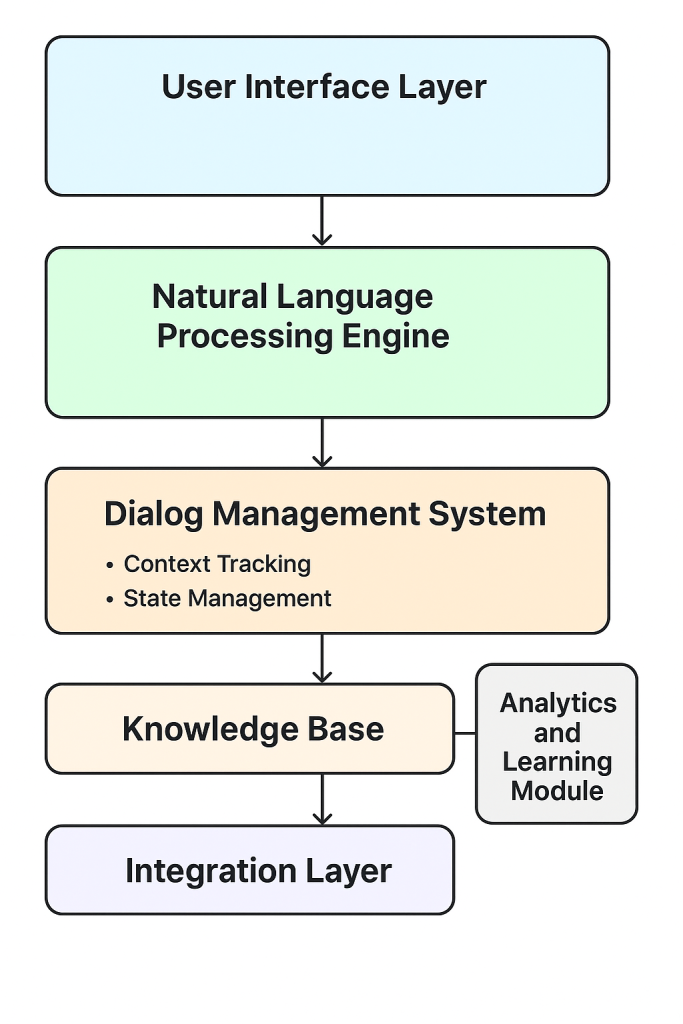
- User Interface Layer: What users view and interact with – the chat window, buttons, and visuals.
- Natural Language Processing Engine: The human language-processing brain, decomposing sentences into useful parts.
- Dialog Management System: The director governing conversation flow, remembering context, and determining what’s next.
- Knowledge Base: Large data refers to the Chatbot references to provide answers and help.
- Integration Layer: CRM, database, or third-party API integration connects the chatbot with other systems.
- Analytics and Learning Module: Monitor performance, learn from interaction and improve reactions.
The Step-by-Step Process
When you send a query to a chatbot, here’s what happens in this duration (milliseconds):
- Input Reception: Your message is captured and pre-processed
- Language Analysis: NLP decomposes grammar, extracts entities, and establishes intent
- Context Evaluation: The system takes conversation history and present context into consideration
- Response Planning: The chatbot makes a determination of how to reply based on available data
- Output Generation: An off-the-shelf human-like response is generated and formatted
- Delivery: The response displays in your chat interface
- Learning: The interaction is analyzed and stored for future optimization
Calculator Concept: Develop a “Chatbot ROI Calculator” that assists companies in estimating cost savings and revenue gains from chatbot adoption based on their existing support metrics.
Real-World Chatbot Examples That Really Work
Theory is wonderful, but let’s discuss chatbot examples that you can actually learn from. The best way to learn about how chatbots work is to watch them work.
Website Chatbot Examples
E-commerce Support: Online businesses use chatbots to manage everything from product recommendations to order status tracking. AI chatbots in ecommerce help to access inventory systems, process returns, and even upsell customers based on browsing cache data or last interactions of the users on your website. Studies show chatbots can improve conversion rates for e-commerce businesses by up to 30%.
Banking and Finance: Chatbots are used for account requests, transaction history and simple financial guidance in bank institutions. The BFSI Chatbot market is estimated to exceed $2 billion by the year 2025. They are particularly favorable for worldly works that do not include human decisions.
Healthcare: Medical sites use a chatbot to appoint schedule planning, symptomatic examination and general health information. They can’t replace doctors, but they’re excellent for triage and basic support.
Interactive Content Platforms: Companies like Outgrow use chatbots to guide users through creating calculators, quizzes, and assessments, making complex processes feel simple and engaging.
Chatbot Conversation Examples
Here’s what effective chatbot interactions look like:
Customer Service Scenario: User: “I have not yet received my order” Chatbot: “I can help you track that order. Can you enter the order number or e-mail address you used?” User: “Order #12345” Chatbot: “I think your order was shipped yesterday and should arrive by Thursday. Here’s your tracking link: [link]. Is there anything else I can help with?”
Sales Support Scenario: User: “What is your return policy?” Chatbot: “We have 30-day returns on all but a few items. Would you like to return something in particular, or are you just looking before buying?” User: “Just looking before buying” Chatbot: “Good thinking! Our returns process is easy – just get in touch within 30 days and we’ll send you a free return label. Ready to shop for our products?”
Lead Generation Scenario: Chatbot: “Hi! I saw that you are interested in our marketing software. Do you want to take our 2-minute quiz to know which interactive material style will be the most effective for your company? User: “Sure!” Chatbot: “Excellent! [Deploys interactive test that gathers lead data while delivering value]”
Build Your Interactive Chatbot with Outgrow
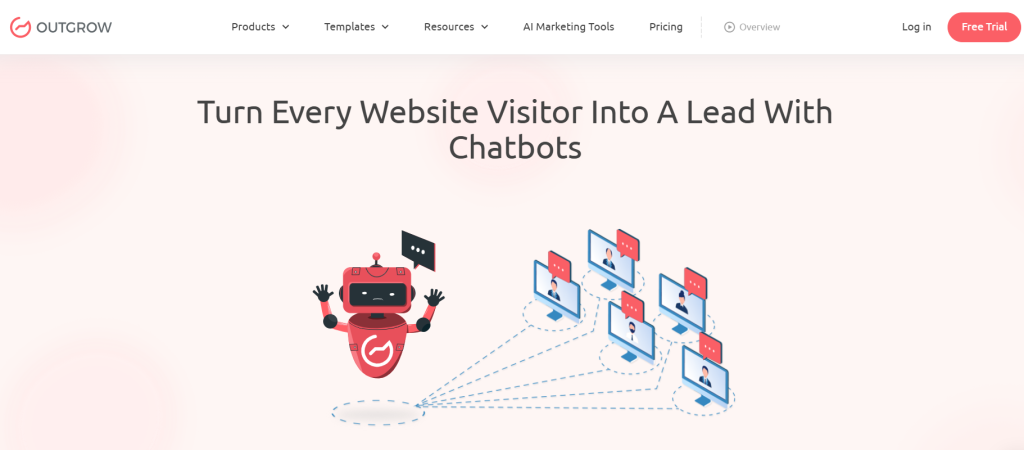
Step 1: Strategy and Planning
Create Your Chatbot’s Goal
- Determine the most frequent user queries or pain areas
- Establish the useful information you can offer with interactive content
- Outline the customer journey from initial interaction to conversion
Select Your Interactive Features
- Calculators for mathematical solutions (prices, savings, ROI)
- Assessments for qualification and recommendation
- Quizzes for learning and engagement
- Polls for feedback and preference collection
Step 2: Content Creation
Create Your Interactive Content With Outgrow’s platform:
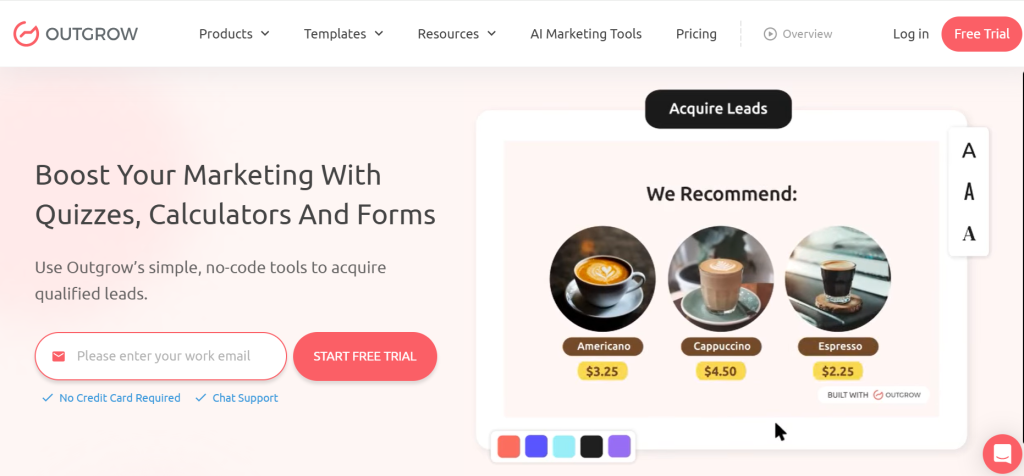
- Choose relevant templates for your application
- Tailor questions to your brand tone
- Implement logic flows on user responses
- Create outcome pages that deliver actual value
- Roll out lead capture forms effortlessly
Craft Conversation Flows
- Develop chatbot scripts that lead into interactive content seamlessly
- Write transition lines that guide users from chat to interactive experiences
- Design follow-up sequences around interactive content results
Step 3: Integration and Testing Mode
Technical Integration
- Integrate Outgrow content into your chatbot platform
- Implement API connections to exchange data smoothly
- Set up lead routing by qualification score
- Thoroughly test all integration points
User Experience Testing
- Test end-to-end user journeys from chatbot to interactive content
- Optimize transition points for smooth user flow
- Confirm mobile compatibility on all devices
- Collect feedback from beta users
Step 4: Launch and Optimization Process
Soft Launch Strategy
- Roll out to a small segment first
- Closely monitor performance metrics
- Collect user input and interaction data
- Adjust based on actual user behavior
Ongoing Improvement
- Measure completion rates for interactive content
- Monitor conversion rates from chatbot interactions
- A/B test various conversation flows
- Refresh content based on seasonal trends or new offerings
Building Your Chatbot Strategy: What You Need to Know
Having learned how chatbots function, let’s discuss executing them well. A chatbot that pleases users and one that disappoints them often comes down to strategy, not just for technology.
Selecting the Right Chatbot Type
Rule-based chatbots perform optimally when:
- You have repeating, predictable questions
- Cost is a constraint
- Compliance demands scripted responses
- The application scenario is specific and narrow
AI chatbots excel when:
- Conversations are multifaceted and diverse
- You need to create personalized experiences
- Learning and adaptation over time is necessary
- Budget enables more advanced technology
Considerations for Implementation
- Start Small, Think Big: Begin with a single definite use case and build up slowly. Trying to make a chatbot that does everything often results in one that does nothing good.
- Design for the audience: Chatbot’s personality and abilities should match users’ expectations and communication style.
- Plan for Failure: Each chatbot will meet situations that do not cope with it. Make beautiful handoffs to human agents when necessary.
- Measure What Matters: Measure resolution rate, user satisfaction, and conversation completion to gain insight into performance. Interactive content generally experiences conversion rates of 37.8% or better with proper deployment.
- Assessment Opportunity: Develop a “Chatbot Readiness Assessment” that assesses whether a business is ready for chatbot adoption and what preparation is required on their part.
Advanced Chatbot Features and Capabilities
New chatbot technology has come a long way from question-and-answer responses. Today’s best chatbots all use advanced features that enable truly useful user experiences.
Contextual Understanding
Advanced AI chatbots keep context during entire conversations. They recall what you talked about previously and use it as reference later, making conversations more natural and fluid.
Multi-channel Integration
The best chatbots also work on many platforms, websites, social media, message apps and even voting assistants. This means that users have a consistent experience regardless of how they choose to interact.
Personalization Engines
AI-powered chatbots can analyze user behavior, preferences and history to provide individual recommendations and reactions. They can learn individual communication patterns and adjust accordingly.
Advanced Analytics
Modern Chatbot platforms provide detailed analysis of user interactions, general questions, conversation bottlenecks and performance metrics. All this data fuels ongoing improvement and business insights.
Interactive Content Integration
Forward-thinking chatbots can be integrated with interactive content such as calculators, quiz and assessment to provide more attractive experience and capture better lead data.
Common Chatbot Mistakes to Avoid
Part of learning about chatbots is learning what doesn’t work. These are the most prevalent pitfalls to dash your chatbot’s potential:
- Overselling Capabilities: Never promise more from your chatbot than it can realistically deliver. When a chatbot overpromises and loses the undelivered quickly, users will quickly lose confidence.
- Ignoring User Intent: Focusing too much on keywords instead of what users actually looking for accomplish leads to frustrating interactions.
- Poor Handoff Design: When Chatbot cannot help, human agents should be smooth and preserve the context of interaction.
- Neglecting Mobile Experience: Most chatbot interactions occur on mobile devices instead of desktop or tablet. Chatbots that aren’t optimized for mobile users create poor user experiences.
- Forgetting About Maintenance: Chatbots need regular updates like data, training, and optimization. Set-and-forget approaches lead to declining performance over time.
- Missing Interactive Opportunities: Static chatbots that only provide text responses miss chances to engage users with calculators, quizzes, or visual content that could boost conversion rates.
Interactive Content + Chatbots: The Winning Combination
Here’s something that most businesses overlook: chatbots are a great fit with interactive content. Instead of just answering questions, they can guide users through calculators, quizzes, and assessments that provide real value when capturing lead information.
Why this is the case: Interactive material has a conversion rate of up to 40% compared to static materials. When you add this to chatbot technology, you have:
- Higher engagement rates
- Better lead qualification
- More personalized experiences
- Increased conversion rates
Implementation Ideas:
- Use chatbots to introduce and explain interactive calculators
- Have chatbots follow up on quiz results with personalized recommendations
- Create assessment flows where chatbots guide users through complex evaluations
- Use chatbot data to personalize interactive content recommendations
Ready to Build Your Own Interactive Chatbot Experience?
Now that you know the technology behind chatbots, why not make it even better? Put the power of chatbot technology together with the interactivity of content to build experiences that really captivate your audience.
Begin Creating Now: Utilize tools such as Outgrow to build interactive calculators, quizzes, and tests that are integrated with your chatbot strategy. With conversion rates reaching 40% above static content, interactive features have the potential to turn your chatbot into a lead generation powerhouse from a mere Q&A system.
Next Steps:
- Identify your top customer questions and pain points
- Create interactive assessments that address these issues
- Use chatbots to guide users through these interactive experiences
- Measure and optimize based on engagement and conversion data
The future of customer engagement isn’t just chatbots or just interactive content – it’s the powerful combination of both working together to create experiences that truly serve your audience.
Frequently Asked Questions About How Chatbots Work
Modern AI chatbots use natural language processing that can be trained on multiple languages. They analyze sentence structure, grammar, and context regardless of language, though performance varies by language and training data quality.
Chatbot accuracy depends on implementation and use case. Rule-based chatbots can achieve 90%+ accuracy for narrow, well-defined tasks, while AI chatbots typically range from 70-95% accuracy depending on complexity and training quality.
Most AI chatbots require internet connectivity to access cloud-based processing power and knowledge bases. Some basic rule-based chatbots can work offline with limited functionality, but AI capabilities generally need online resources.
Chatbots integrate with business systems through APIs and databases. They can access customer information, inventory data, appointment systems, and other tools to provide comprehensive assistance while maintaining data security.
Small businesses often benefit from simpler, rule-based chatbots for basic customer service and lead generation. Large enterprises typically implement more sophisticated AI chatbots with complex integrations and advanced capabilities.
Interactive content like calculators, quizzes, and assessments can boost chatbot engagement by up to 40%. They provide more value to users while capturing better lead data and creating more memorable experiences than text-only interactions.
Track metrics like cost per interaction, conversion rates, customer satisfaction scores, and time savings. Compare these against your previous manual processes to calculate true ROI.

Ankit Upadhyay is a Digital Marketing and SEO Specialist at Outgrow. With a passion for driving growth through strategic content and technical SEO expertise, Ankit Upadhyay helps brands enhance their online visibility and connect with the right audience. When not optimizing websites or crafting marketing strategies, Ankit Upadhyay loves visiting new places and exploring nature.


